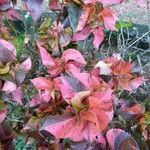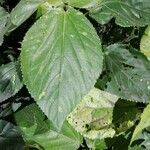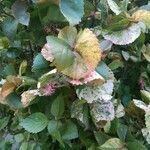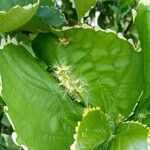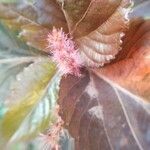Shrubs, 1-3 m tall, monoecious. Young branchlets pubescent. Stipules narrowly triangular, ca. 8 mm; petiole 2-3 mm, pilose; leaf blade broadly ovate, 10-18 × 6-12 cm, often colored or red-or purple spotted, abaxially pilose along veins, base obtuse, margin coarsely crenate, apex acuminate; basal veins 3-5. Inflorescences axillary, unbranched, unisexual. Male flowers 9-17, glomerate; inflorescences 10-20 cm, pilose; bracts lax, ovate, ca. 1 mm; pedicel ca. 1 cm; sepals 4, ovate, ca. 0.7 mm; stamens 8. Female flowers 1(or 2) in each bract, sessile; inflorescences 5-10 cm; peduncle ca. 2 cm; bracts broadly ovate, ca. 5 × 8 mm, 7-11-serrate; sepals 3 or 4, ovate-lanceolate, 0.5-1 mm, ciliate; ovary pubescent; styles 3, 6-7 mm, 9-15-laciniate. Capsule ca. 4 mm in diam., sparsely villous. Seeds globose, ca. 2 mm in diam., smooth. Fl. year-round.
An evergreen shrub. It grows 3 m high and spreads 2 m across. The stem is erect with many branches. The branches have fine hairs. It has a closely arranged crown. The leaves are coppery green with red splashes of colour. This gives them a mottled appearance. The leaves are large and broad with teeth around the edge. They can be 10-20 cm long and 15 cm wide. The leaves are finely hairy. They can be flat or crinkled. The flowers are reddish in spikes at the end of branches. They have separate male and female flowers on the same plant. The male flowers are in long spikes which hang downwards while the female flowers are in short spikes. They do not show up easily as they are often hidden among the leaves. The flower stalks are 10-20 cm long.
Shrub, erect, spreading, to 2 m high. Branchlets: lenticels absent; flaky bark absent. Leaves eglandular; lamina ovate, 70–250 mm long, 50–150 mm wide; base cordate, cuneate or obtuse; margin crenate; tip acute to short acuminate; venation palminerved with 5 veins from base and 9–12 lateral veins per side of midrib further up the lamina. Inflorescences axillary and single, racemose or spicate, usually unisexual. Male flowers: sepals lanceolate, 0.8–0.9 mm long; stamens 8. Female flowers ± sessile: sepals lanceolate-ovate, 1–1.2 mm long; styles 2.5–9 mm long, red. Fruit depressed-globose, 2.5–2.7 mm long, 3–3.2 mm diam. Seeds oblong, c. 2 mm long, 1.3 mm wide.
Leaf blades usually up to 15 × 10 cm, sometimes larger, elliptic-ovate to broadly ovate, obtusely acuminate at the apex, crenate-dentate on the margins, cuneate or rounded at the base, 5–7-nerved from the base, membranous, sparingly pubescent along the midrib and main veins on both surfaces at first, later glabrescent, green, copper or bronze and variously variegated with purple, red, pink, cream-coloured or white, or else pink-, cream-or white-margined; lateral nerves in 6–10 pairs.
Female spikes up to 7 cm long, lax flowered; bracts c. 5 × 4 mm, ± ovate, later accrescent, dentate, with 3–6 teeth on each side, sparingly pubescent to subglabrous, 1-flowered.
Female flowers sessile; sepals 3–4, 1 mm long, ovate, subacute; ovary 1.5 mm in diameter, subglobose, tomentose; styles c. 6 mm long, united at the base, deeply laciniate, red.
Inflorescences axillary, usually solitary, spicate, unisexual, on the same or different shoots.
Male spikes up to 12 cm long, densely but interruptedly flowered; bracts minute, many-flowered.
A densely branched rounded shrub mostly 1–2 m tall, monoecious, tomentellous to pubescent.
Male flowers sessile or ± so; buds tetragonal, subglabrous, reddish; anthers yellowish.
Stipules 7 mm long, narrowly lanceolate, acutely acuminate.
Fruits 1.5–2 × 4 mm, 3-lobed, pubescent.
Seeds not set in Africa.
Petioles 1–5 cm long.
